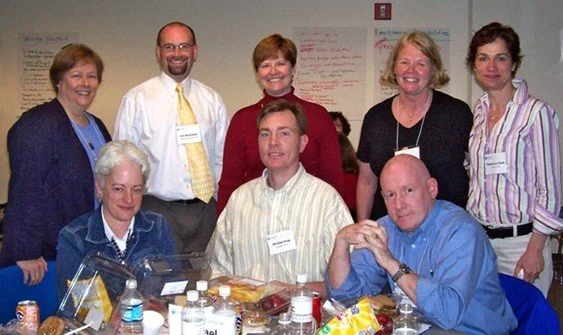Creating a ripple in the system
Class of 2008 - Team 3
Much like Leadership Eastside, Class of 2008 “Team 3” started out with a lofty vision “Community Consciousness Raising: The Dawn of the Sunrise Side.” We decided this on the afternoon of the first Leader Day of the first Cohort, affectionately known as the “Low Hanging Fruit.” On the second day, we experienced some consciousness raising of our own as we were introduced to the Seattle Foundation’s Seven Characteristics of a Healthy Community, which lead us to refine our project focus to exploring hunger on the Eastside.
Team 3 met at the Kirkland Library every Thursday morning at 7:30am to map out our learning journey, which included several interviews of people and organizations dealing with hunger in our region. This led us to an evening cooking and serving a dinner to those living in Tent City 4. In an effort to understand hunger as it relates to those that still have housing, we turned to Hopelink. Their six foodbanks served over 15,000 people on the Eastside representing 90 different languages, dialects, and ethnicities. The Hopelink staff pointed out that many of the people that they served didn’t speak or read English, and didn’t understand American foods, which added additional challenges to those running the foodbanks.
To get a better idea of how these challenges impacted how the food banks operated, the Team decided to work a shift. The food at the Hopelink food bank had consisted of boxed or canned foods, all of which had labels printed in English. Our experience at the foodbank left us questioning whether or not what was available met the cultural needs of those from different immigrant cultures.
As our main project, we decided to gather focus groups of non-English speaking clients. We worked with interpreters to listen to the needs of immigrant populations that the foodbanks served. What we learned was that many of these people relied on diets that consisted of fresh produce, rice, meat and spices, rather than canned or boxed meals. This was a challenge for the foodbanks, which lacked refrigeration units on site.
We shared the results of our focus groups with Hopelink, who then incorporated it into the request they made to United Way for a grant to purchase refrigerators for their food bank sites. The grant was awarded and the food banks were able to begin providing produce.
In 2010, Hopelink led an effort to research community awareness of and attitudes towards local areas of food insecurity. Some of the members of Team 3 were invited to join that effort. The results led to the formation of an intriguing model of engagement and action later to be called the Nourishing Networks.
Since the project in 2006, Hopelink has engaged in many community and client conversations to understand how best to serve the community. Today, Hopelink markets look like a Trader Joe’s with a long wall of fresh fruits and vegetables, fresh flowers, and aisles with food options. In addition, they have added a mobile food market that goes out to communities that have a harder time getting to the established food markets. It has been exciting to see the change that happens over time and how our project created a ripple that Hopelink used to make significant changes to how our community is served.




